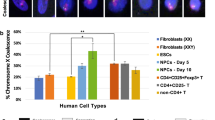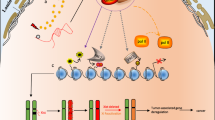Abstract
The X chromosome in mammalian somatic cells is subject to unique regulation—usually genes on a single X chromosome are expressed while those on other X chromosomes are inactivated1. The X-locus for steroid sulphatase (STS; EC 3.1.6.2), the microsomal enzyme that catalyses the hydrolysis of various 3β-hydroxysteroid sulphates, is exceptional because it seems to escape inactivation. Evidence for this comes from fibroblast clones in females heterozygous for mutations that result in a severe deficiency of this enzyme in affected males; all clones from these heterozygotes have STS activity, and enzyme-deficient clones that are expected if the locus were subject to inactivation2, have not been found3. Further evidence that the STS locus escapes inactivation is that the human inactive X chromosome contributes STS activity to mouse–human hybrid cells4. On the basis of these hybrid studies5,6 the STS locus has been mapped to the distal half of the short arm (p22–pter) of the human X chromosome. Although the STS locus on both X chromosomes in human female cells is expressed, quantitative measurements of STS activity in males and females do not accurately reflect the sex differences in number of X chromosomes7–13 (Table 1). The ratio of mean values for normal females to that of normal males is greater than 1:1 but less than the ratio of 2:1 expected if STS loci on all X chromosomes were equally expressed. The incomplete dosage effect suggests that the STS locus on the inactive X chromosome might not be fully expressed. To test this hypothesis, we examined two heterozygotes for X-linked STS deficiency who were also heterozygous for the common electrophoretic variants of glucose-6-phosphate dehydrogenase (G6PD A and B). Studies of fibroblast clones from these females provide evidence, presented here, for differential expression of STS loci on the active and inactive X chromosome.
Similar content being viewed by others
References
Lyon, M. F. Biol. Rev. 47, 1–35 (1972).
Migeon, B. R. et al. Proc. natn. Acad. Sci. U.S.A. 78, 5066–5070 (1981).
Shapiro, L. J., Mohandas, T., Weiss, R. & Romeo, G. Science 204, 1224–1226 (1979).
Mohandas, T., Sparkes, R. S., Hellkuhl, B., Grzeschik, K. H. & Shapiro, L. J. Proc. natn. Acad. Sci. U.S.A. 77, 6759–6763 (1980).
Mohandas, T., Shapiro, L. J., Sparkes, R. S. & Sparkes, M. C. Proc. natn. Acad. Sci. U.S.A. 76, 5779–5783 (1979).
Müller, C. R., Westerveld, A., Migl, B., Franke, W. & Ropers, H. H. Hum. Genet. 54, 201–204 (1980).
Müller, C. R., Migl, B., Traupe, H. & Ropers, H. H. Hum. Genet. 54, 197–199 (1980).
Ropers, H. H. et al. Hum. Genet. 57, 354–356 (1981).
Bedin, M., Weil, D., Fournier, T., Cedard, L. & Frezal, J. Hum. Genet. 59, 256–258 (1981).
Lykkesfeldt, G., Bock, J. E. & Lykkesfeldt, A. E. Lancet ii, 255–256 (1981).
Epstein, E. H. Jr & Leventhal, M. E. J. clin. Invest. 67, 1257–1262 (1981).
Dancis, J., Jansen, V. & Hutzler, J. Pediat. Res. 14, 521 (1980).
Shapiro, L. J., Weiss, R., Webster, D. & France, J. T. Lancet i, 70–72 (1978).
Mareni, C. & Migeon, B. R. Am. J. hum. Genet. 33, 752–761 (1981).
Shapiro, L. J. et al. Lancet ii, 756–757 (1978).
Baum, H., Dodgson, K. S. & Spencer, B. Clinica chim. Acta 4, 453–455 (1959).
Cattanach, B. M. Z. VererbLehre 92, 165–182 (1961).
Eicher, E. Adv. Genet. 15, 175–259 (1970).
Mohandas, T., Sparkes, R. S. & Shapiro, L. J. Am. J. hum. Genet. (in the press).
Belote, J. M. & Lucchesi, J. C. Nature 285, 573–575 (1980).
Ohno, S. Sex Chromosomes and Sex-linked Genes, 99 (Springer, New York, 1967).
Lyon, M. F. Proc. R. Soc. B 187, 243–268 (1974).
Lucchesi, J. C. Science 202, 711–716 (1978).
Migeon, B. R., Wolf, S. F., Mareni, C. & Axelman, J. Cell 29, 595–600 (1982).
Hameister, H. et al. Hum. Genet. 46, 199–207 (1979).
Author information
Authors and Affiliations
Rights and permissions
About this article
Cite this article
Migeon, B., Shapiro, L., Norum, R. et al. Differential expression of steroid sulphatase locus on active and inactive human X chromosome. Nature 299, 838–840 (1982). https://doi.org/10.1038/299838a0
Received:
Accepted:
Issue Date:
DOI: https://doi.org/10.1038/299838a0
- Springer Nature Limited
This article is cited by
-
Dosage compensation of the active X chromosome in mammals
Nature Genetics (2006)
-
Embryonic growth and the evolution of the mammalian Y chromosome. II. Suppression of selfish Y-linked growth factors may explain escape from X-inactivation and rapid evolution of Sry
Heredity (1994)
-
Maintenance of X inactivation of theRps4, Zfx, andUbe1 genes in a mouse in vitro system
Somatic Cell and Molecular Genetics (1993)
-
An evaluation of the inactive mouse X chromosome in somatic cell hybrids
Somatic Cell and Molecular Genetics (1993)
-
Structure of the X–linked Kallmann syndrome gene and its homologous pseudogene on the Y chromosome
Nature Genetics (1992)





